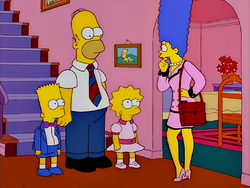
Scenes from the Class Struggle in Springfield/References
Wikisimpsons - The Simpsons Wiki
< Scenes from the Class Struggle in Springfield
Revision as of 13:08, August 31, 2024 by Simpsons88 (talk | contribs)
|
|||||||||
|
|
|
Cultural references
- The episode title is a reference to the 1989 black comedy film Scenes from the Class Struggle in Beverly Hills, which depicts a series of sexual entanglements and comic confusions between a group of rich Beverly Hills socialites and their servants.
- According to Lisa, The Nature Company has a TV assembled by Hopi indians. The Hopi are Native Americans who primarily live in northeastern Arizona.
- When Bart and Homer look at television sets in the Ogdenville Outlet Mall, the off-brand sets they see include Magnetbox, Panaphonics and Sorny, puns on Magnavox, Panasonic and Sony, respectively.
- Brandine works at Dairy Queen, the American multinational fast food chain.
- Marge wonders if the dress Lisa found is a real Chanel.
- Lisa compares Marge to American TV personality Mary Hart.
- Marge once treated herself with Sanka, a brand of instant decaffeinated coffee and one of the earliest decaffeinated varieties.
- The opera playing on the TV is La traviata by Giuseppe Verdi, and the aria heard is "Sempre libera".
- Socialite Evelyn Peters was about to call the American Automobile Association, also known as the "Triple A", to pump fuel in her car.
- Evelyn owns a Mercedes-Benz W124 station wagon.

Homer wants to go to the Springfield Glen Country Club dressed as Andy Sipowicz, the main character from NYPD Blue, but is not allowed by Marge
- When Marge tells Homer not to wear a tie with a short-sleeved shirt, Homer protests that "Sipowicz does it", referring to the character Andy Sipowicz on NYPD Blue who usually seen wearing striped ties and short-sleeved shirts.
- Roberta orders her steaks through The New Yorker, the popular American magazine.
- According to Susan, the retail company L.L.Bean and clothing store chain Eddie Bauer are selling her the same honey.
- Marge compared the country club house to the Playboy Mansion.
- Lisa's line "" is a reference to the line "Let me tell you about the very rich. They are different from you and me" found in the 1925 novel The Great Gatsby by American writer F. Scott Fitzgerald.
- When Homer takes up golfing, he reads the book titled The New Our Caddies, Ourselves, which parodies the women's health book Our Bodies, Ourselves.
- On the book's cover, two men are holding a sign with the concept "Fore" written on it. In the real book, Our Bodies, Ourselves, two women are holding a "Woman Unite" sign in the same way.
- The description "A book by and for golfers" parody the "A book by and for women" found in the real-world book.
- When Homer tells Marge that Kennedy and Lincoln had the same golf handicap, it is a reference to the many putative similarities between Presidents Lincoln and Kennedy.
- Mr. Burns played golf against Richard Nixon in 1974. A hint to the Watergate scandal is made by Burns when he imitates a worried Nixon.
- Mr. Burns calls Homer "Steinmetz", in a reference to the American engineer Charles Proteus Steinmetz, when he is thinking too much on which club to choose.
- The employee at Steppin' Out mentions Sears, an American chain of department stores.
- Marge's line "I wouldn't want to join any club that would have me as a member" is a reference to the phrase "I don't want to belong to any club that will accept me as a member" by comedian and actor Groucho Marx.
Goofs
- The layout of the price tags changed between when Homer and Bart first walk into the store at the outlet mall and in the closeup of Bart.
- When Marge smiles after Evelyn leaves the Kwik-E-Mart gas station, her lipstick disappears. It reappears when Mr. Burns pulls up.
- When Lisa is first shown riding the horse, the horse's eye is colored solid red.
Continuity
- Marge gets her dress at a store in Ogdenville. Ogdenville was last mentioned in the episode "Marge vs. the Monorail" in season 4. In that episode, it was one of the places where Lyle Lanley sold monorails.
